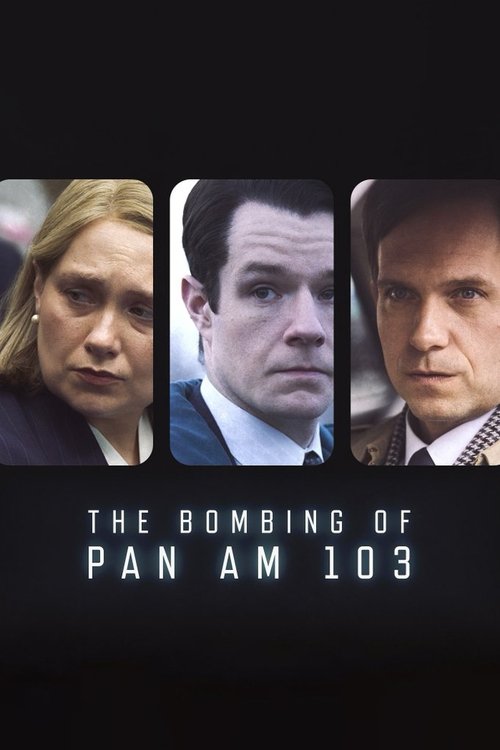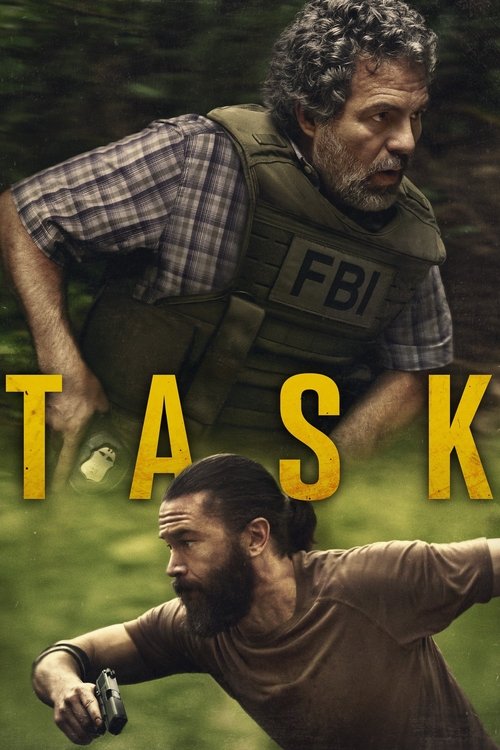
Ask Your Own Question
What is the plot?
The Bombing of Pan Am 103 begins in 1988 with scenes of passengers boarding Pan Am Flight 103 at Heathrow Airport, preparing to fly to New York for Christmas. The atmosphere is ordinary and festive, with travelers excited to reunite with loved ones. The plane takes off without incident, but shortly after, a bomb hidden inside a suitcase in the cargo hold detonates mid-flight over the small Scottish town of Lockerbie, causing the aircraft to explode and crash, killing all 243 passengers and 16 crew members on board, as well as 11 people on the ground.
The immediate aftermath shows the devastation in Lockerbie, with emergency responders and local residents confronting the wreckage scattered over an 850 square mile area. The scene is chaotic and harrowing, with bodies and debris everywhere. Investigators begin collecting evidence, including thousands of pieces of wreckage and personal belongings, focusing on the fragments of the suitcase that contained the bomb.
The story then shifts to the British and American law enforcement agencies launching a joint investigation. DS Ed McCusker and DCS John Orr lead the Scottish police effort, while FBI Special Agent Dick Marquise arrives from the United States to assist. The investigators face immense pressure to find the perpetrators quickly. They meticulously analyze the forensic evidence, including bomb fragments and luggage tags, piecing together the chain of events that led to the bombing.
A key breakthrough occurs when investigators trace the suitcase to a specific route involving multiple flights and transfers, eventually linking it to a Maltese shop where the bomb was believed to have been packed. This discovery leads to the identification of two Libyan suspects, Abdelbaset al-Megrahi and Al Amin Khalifa Fhimah. The investigation reveals that the bomb was constructed using Semtex explosives and detonated by a timer device.
As the investigation progresses, the team faces political and diplomatic challenges. The British and American governments push for justice, but Libya denies involvement, complicating efforts to extradite the suspects. The investigators persist, gathering intelligence and witness testimonies, including from informants and experts like Edwin Bollier, who provide insight into the bomb's components and origins.
Tensions rise as the suspects are formally indicted, and the case moves toward prosecution. The drama portrays the painstaking legal preparations, including the decision to hold the trial in the Netherlands under Scottish law to ensure fairness and security. Throughout, the series highlights the emotional toll on the victims' families, who demand answers and justice amid the prolonged investigation.
In the courtroom sequences, the prosecution presents detailed forensic evidence and witness accounts linking the suspects to the bombing. The defense challenges the credibility of the evidence and witnesses, leading to intense confrontations and cross-examinations. The trial exposes the complexities of international law and the difficulties in securing a conviction for such a politically charged case.
The series concludes with the conviction of Abdelbaset al-Megrahi, who is found guilty of murder for his role in the bombing. The verdict brings a measure of closure but also controversy and debate, as questions about the full truth and possible conspiracies linger. The final scenes reflect on the enduring impact of the tragedy on Lockerbie, the victims' families, and the global fight against terrorism.
What is the ending?
The TV miniseries The Bombing of Pan Am 103 (2025) concludes with the investigators piecing together the complex evidence surrounding the 1988 disaster, but it leaves viewers with a sense of unresolved tension and the heavy cost of the tragedy. The ending underscores the enduring impact on the families and the community of Lockerbie, while highlighting the intricate political and intelligence battles fought behind the scenes.
Expanded, scene-by-scene narrative of the ending:
The final episodes open with the investigative team, led by DS Ed McCusker (Connor Swindells) and FBI Special Agent Dick Marquise (Patrick J. Adams), working tirelessly to unravel the connections behind the bombing. They sift through the evidence recovered from the wreckage scattered around Lockerbie and the intelligence reports from British and American agencies. As they uncover clues--such as bomb fragments, evidence of an explosive device, and suspect communications--the tension mounts.
One pivotal scene depicts the investigators facing bureaucratic hurdles and internal conflicts between agencies. DS McCusker and Agent Marquise meet in tense private discussions, debating how to proceed with incomplete evidence and amid political pressures. The difficulty of securing cooperation from intelligence services strains their efforts.
The story then shifts to the Lockerbie community where the local residents and families of victims grapple with the enormous loss. Scenes of memorials and personal mourning underscore the human tragedy behind the political intrigue. Key characters such as Moira Shearer (Phyllis Logan) and June McCusker (Lauren Lyle) are shown coping with grief, highlighting the deep and persistent emotional scars.
As the investigation narrows down, the focus falls on implicating suspects linked to Libya, reflecting the geopolitical realities of the time. The investigators confront the complexities of proving involvement, as suspects deny allegations and political will wavers.
The climax involves a dramatic confrontation at a critical inquiry or hearing where evidence is presented but full resolution remains out of reach. The narrative does not offer a neat closure, instead emphasizing the nature of this event as an ongoing struggle for truth and justice.
In the closing scenes, the miniseries shifts to a broader perspective, depicting the wider ramifications: the bombing as an act of war that challenges national security protocols and exposes flaws in international cooperation. The final moments show investigators and families continuing their fight, symbolizing that the story of Pan Am 103 remains alive, fueled by the need to remember and seek accountability.
Overall, the miniseries ends on a solemn, reflective note, focusing on the painstaking investigation, the personal toll on all involved, and the wider geopolitical conflict, rather than delivering a simple resolution. The closing narration or title cards remind viewers that the bombing was the deadliest terrorist attack in British history and a watershed moment in global security.
Who dies?
Yes, in the TV show The Bombing of Pan Am 103 (2025), characters do die, primarily because the series depicts the real-life tragic events of the 1988 Pan Am Flight 103 bombing. The disaster resulted in the deaths of all 243 passengers and 16 crew members on board, totaling 259 fatalities, as the plane exploded over Lockerbie, Scotland, due to a bomb hidden in a tape recorder placed in checked luggage.
The circumstances are as follows:
- The bombing occurred on December 21, 1988, shortly after Pan Am Flight 103 took off from London Heathrow Airport en route to New York City.
- A bomb, smuggled aboard inside a cassette player, detonated mid-air, destroying all communication systems and causing the aircraft to explode at high altitude.
- The explosion led to the complete loss of the aircraft, killing everyone onboard instantly.
- Additionally, 11 people on the ground in Lockerbie were killed by falling debris from the crash.
Since this TV show is a dramatization of these investigative events and consequences, the deaths of the flight victims are central to the story rather than individual fictional characters whose deaths are explored separately. The focus is on the investigations by British and American authorities attempting to uncover the perpetrators behind this catastrophic terrorist attack.
Therefore, all characters who were passengers and crew aboard Pan Am 103 die in the bombing under the conditions described. The series likely represents this event with those tragic deaths as a factual premise, but the detailed fate of other investigative characters is not explicitly specified in the available references.
References:
- Deaths of 243 passengers and 16 crew on Pan Am 103 on December 21, 1988, caused by a bomb explosion during the flight.
Is there a post-credit scene?
The TV show The Bombing of Pan Am 103 (2025) does include a post-credit scene. In this scene, the narrative focuses on Dr. Jim and Jane Swire, parents of one of the victims, as they pack up the home where their daughter Flora was raised. Jim is shown taking down documents from a conspiracy wall, reflecting on the tragic loss and the ongoing quest for truth about the bombing. The scene conveys a sense of tentative closure, with Jim beginning to accept that definitive answers about the attack may never fully emerge, even as he remains committed to uncovering the truth.
This post-credit moment serves as a poignant coda to the series, emphasizing the personal and emotional aftermath of the tragedy alongside the official investigations depicted throughout the show.
What are the main events covered in the investigation of the Pan Am 103 bombing in the series?
The series covers the initial suspicion of a Palestinian terror group funded by Iran, the discovery of evidence pointing to Colonel Gaddafi's Libya, the involvement of a Libyan double agent providing crucial evidence, and the trial of the bombing suspects, including the changing testimony of a key witness. It also shows the aftermath with a shocking verdict and later fresh evidence raising questions about the truth.
How does the series portray the different perspectives on who was responsible for the bombing?
The series presents multiple perspectives, including the initial suspicion of a Palestinian terror group funded by Iran and evidence implicating Libya. It highlights that intelligence reports classified by the British government point to both Iran and the Popular Front for the Liberation of Palestine – General Command (PFLP-GC), as well as Libya. The show also depicts the ongoing disagreement among victims' families and investigators about the true culprits.
What role do the families of the victims play in the story?
The families of those on board Pan Am 103 are shown learning about the tragedy, participating in the investigation process, and reacting to the trial and verdict. The series also portrays their ongoing struggle for truth and justice, including their differing views on the convicted suspect's release and the unresolved questions that remain decades later.
How is the trial of the bombing suspects depicted in the series?
The trial is depicted as complex and contentious, with the CIA handing over a Libyan double agent who provides key evidence. However, the trial is marked by a key witness changing his story, leading to a verdict that leaves many victims' families unsatisfied. The series also shows the long-term impact of the trial and the emergence of fresh evidence years later that challenges the official narrative.
Does the series address the ongoing controversies and unanswered questions about the bombing?
Yes, the series explicitly shows that despite the conviction of al-Megrahi, there has never been a fully independent investigation, and many questions remain unanswered. It presents the continuing debate over the true perpetrators, the political complexities involved, and the differing opinions among families and officials, emphasizing that the story is not fully resolved even decades after the event.
Is this family friendly?
The TV miniseries The Bombing of Pan Am 103 (also known as Lockerbie) produced in 2025 is a historical drama focused on the 1988 terrorist bombing of Pan Am Flight 103 over Lockerbie, Scotland. This event was the deadliest terrorist attack in British history and resulted in the deaths of 270 people.
Regarding family-friendliness: - The series deals with real-life tragedy, including scenes depicting the aftermath of the bombing, investigation, and the effects on victims' families and the local community. - Expect emotionally intense and potentially distressing scenes due to the subject matter involving terrorism, death, and loss. - Graphic depictions of violence or disaster aftermath might be present due to the nature of the story, which could be upsetting for children or sensitive viewers. - It is categorized as a historical drama and special interest genre and not specifically designed for younger audiences.
In summary: - The Bombing of Pan Am 103 is not family-friendly in the sense of being suitable for children. - The series may contain potentially upsetting or objectionable content related to terrorism, death, and the emotional trauma experienced by survivors and families, although plot spoilers are avoided here. - Sensitive viewers should exercise caution and consider the mature and serious themes before viewing.
No specific content warnings like explicit language or graphic violence details were listed in the search results, but the subject matter alone suggests mature and sensitive themes throughout.

































